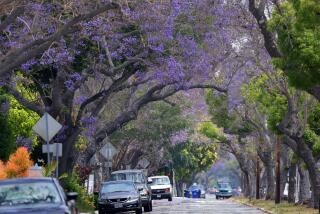Quest for Camouflage Has Happy Ending
- Share via
Those who have followed my power pole saga know that I’ve been trying to hide an extra-ugly pole that suddenly appeared when neighbors had an old tree cut down.
I had narrowed the list to several potential pole-hiding trees and decided that the next step was to look at as many as I could, in the ground and in nursery containers. Choosing a tree is the biggest decision a gardener gets to make.
A visit to various Southland arboretums turned up most as mature trees, so I could see what they would eventually look like. Finding them at nurseries was much more difficult, because few nurseries carry many trees these days thanks to the cost of land.
I fell back on an old favorite, John Boething’s Treeland Nursery out in Woodland Hills.
I’m told it’s been there since 1952, when nurseries were spacious and filled with trees for the new suburbs. Treeland has some 25 acres devoted to trees in containers of various kinds.
The valley air was warm and dry as I drove up, and the mountains were crystal clear in the distance. You enter the nursery on a dirt road and park under old California sycamores.
Golden grasses, oaks and wild walnuts turning bright colors in this colder-than-usual autumn covered a hillside, the low, late-autumn sun illuminating the leaves like stained glass shards.
Does anyone still wonder why fall is such a great season for gardening? There were rows and rows of trees in big wooden boxes and in extra-large plastic containers. A boxed sour gum or tupelo Nyssa sylvatica was turning bright red by the sign on a weathered wood building that said “Information.” This is where I met experienced gardener and nurseryman (and former stockbroker) Bill Schoenbeck.
He approved of my short list of trees, took me around to look at each and offered valuable advice, such as how big he has seen them become or how well they do in West Los Angeles, where he had lived for many years. Naturally, a lot of Boething’s trees do best in the valley.
My short list included a geijera, shoestring acacia, Agonis flexuosa, sweet shade and willow pittosporum (Pittosporum phillyraeoides). Treeland was the only retail nursery I had called that had all five.
All five are short trees, growing to less than 25 or 30 feet tall (the height of a power pole), and all are lacy, several even weeping in form like a willow.
I had been convinced by Randall Williams, who is a landscape architect and the manager of Southern California Edison’s tree program, that I really didn’t want to grow something that would end up in the power lines, where the power company (Department of Water and Power in my case) would have to top or mangle the tree to keep it out of the lines.
I also wanted the tree to be reasonably fast-growing but more or less permanent. I did not want to wait for a shrub to grow tall enough to be called a tree, and I ruled out temporary fixes, such as planting ivy at the power pole’s base, or morning glories, which one power company person had called a “lineman’s nightmare.”
So I was down to this short list of interesting trees that would probably look good in my backyard next to two citrus, not too far from a flaxleaf paperbark, Melaleuca linariifolia. These might not be the best choices in all backyards, but they seemed right for mine.
Schoenbeck, however, added another to my list, Podocarpus henkelii, a slow-growing, vertical tree with drooping foliage. It is rapidly becoming a trendy tree among designers, and for good reason. Although after looking at a few spectacular specimens, I decided it was a little too exotic-looking for my garden and was perhaps better used as a property-line screen.
Luckily, my wife was along to help make this weighty decision. I tend to look at plants in their nursery cans when deciding which to plant, then I find a place for them in the garden. She can visualize them in the garden.
I really liked the acacia with its incredibly long but thin leaves (and will probably find a place for it elsewhere in the garden), and the sweet shade with its shrublike foliage and fragrant flowers, but the willow pittosporum won out.
It didn’t look that great in a nursery can, but its dark, willowy foliage, thin and slightly twisted, would make a fine foil for the broader citrus leaves nearby. The deal was clinched when Schoenbeck showed me a photo of it in Bob Perry’s “Landscape Plants for Western Regions” (Land Design Publishing, 1992). A graceful tree, indeed, that would shame the power pole into the background.
“That’s the one I would have picked,” said Schoenbeck as the tree was delivered to my car on a cart.
Getting a 15-gallon-size tree home was no problem, as long as no one followed too close behind on the drive back to West L.A. The tree stood almost 11 feet tall in its container, so it stuck out of the trunk a good seven feet.
Nurseryman Justin Winston helped me load it and wrapped black plastic bags around the foliage to keep the leaves from getting windburn or blowing off. I secured the trunk lid, used a rag to cushion the trunk lid where it hit the tree and tied a bright red flag to the tree’s tip to make my precious load legal.
I ordered a smaller, 5-gallon size from one of Treeland’s growing fields (it was temporarily out of stock) so I could plant a pair by the pole, making a mini-grove.
We also loaded two tall, sturdy wood stakes, so I could properly stake the rather spindly 15-gallon pittosporum once it was in the ground. It’s still fall, and while this is a great time to be planting trees, it is also the season of the Santa Ana.
I put the skinny tree right in front of the power pole, a decision I hope I don’t regret as the tree grows. The pole is only about three feet away.
It had already rained, so digging a big hole was easy. But I was careful not to dig it too deep, because trees do better if they are on solid, undisturbed soil that won’t settle with time. I added nothing to the backfill, because trees do best with no soil amendments. I did mix a little slow-acting organic fertilizer into the soil.
I untangled a few roots that might have become constricting, although the tree was not the least bit root-bound (a problem when trees sit too long in containers). I watered the hole when it was half-full, then filled it the rest of the way with soil, lightly packing the soil down.
I cut off the stake the tree came with, and then drove two sturdy stakes about 14 inches away from, and on either side of, the trunk.
I found where the trunk was most limp and used plastic ties between each stake and the trunk so the trunk could gently sway in the breezes (which makes it stronger, like flexing one’s muscles). The tree looked great in its new spot and happy to be there.
A few days afterward, it rained, another good reason to plant in the fall. Nothing waters-in a new plant so gently or so thoroughly.
In established neighborhoods such as mine, you don’t often get the chance to plant a tree. If anything, there are already too many to leave much sun for vegetables and flowers.
But it’s a deeply satisfying experience when you follow all the tree-planting rules, and the tree actually seems happy and vibrant, once you cut it from its stake and it’s swaying in the gentle offshore autumn breezes.
Proper planting practices should also make the tree grow fast, so it will be hiding that power pole in no time.
(BEGIN TEXT OF INFOBOX / INFOGRAPHIC)
In Pole Position
Treeland’s list of pole-hiding trees (from landscape designer John Bates and nurseryman Bill Schoenbeck):
* Agonis flexuosa
* Cupania
* Geijera
* Maytenus
* Pittosporum phillyraeoides
* Podocarpus henkelii
* Rhus lancea
* Tristania laurina






